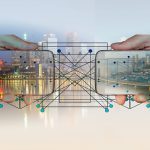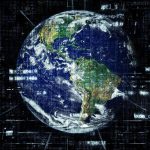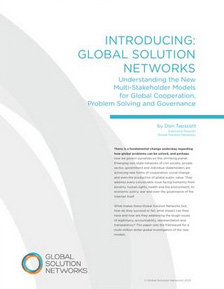Engaging The Population of a City to Reinvent Itself as a Smart Connected Municipality
The digital revolution is enabling the transformation of cities. The old industrial age model of the city is giving way to new open networked models of everything from local government to education, transportation and the power grid.
For example, with all the changes in the world economy and with the strong public demand for government accountability and transparency, there is now a great opportunity for city and state governments to redefine their relationship with the public they serve. The net-generation is both interested in participating with government on issues and at the same time apprehensive that the governments will respond to their needs.
Just as businesses are restructuring to leverage the changing demographics of the knowledge workers, governments need to change how they engage their public.
The Tapscott Group has developed a methodology to develop a strategy and a project road map that leverages the power of social networking to engage the public in key dimensions of urban transformation. The methodology starts with an understanding of the “Ten Dimensions for Transformation” and is followed by an in-depth understanding of your culture, challenges and priorities. The process then maps the “Engagement Strategies” (what has worked before in other situations) to your unique needs, resulting in a strategy and a project road map.
The Tapscott Group has put together a world-class team of experts in the planning and implementation of practical and effective social strategies.
Ten Dimensions for Transformation
The Tapscott Group has developed the “Ten Dimensions for Transformation”, a process by which guides a city or state government through their issues, reviews the twelve strategies to engage the public and results in a social network strategy and project road map.
- Transformation Description
- Economic Development The Digital Revolution enables innovation, new modes of wealth creation. It also promotes entrepreneurship as small companies can have many of the capabilities of large companies without the main liabilities and obstacles. Cities can become richer, generating new jobs and reducing poverty, as growth can be more inclusive. A smart city is also more likely to attract and retain businesses.
- Public Safety Smart connected cities have smarter and more connected law enforcement agencies. Networks enable dramatic increases in visibility, simplify the ease and accuracy of citizen reporting, and keep accurate and visible statistics on police follow-up, conviction rates, etc. This enables the city to provide objective measures of whether things are getting better or worse, and help highlight geographically where it needs to set priorities.
- Open Government The Digital Revolution can make many, appropriate aspects of governing visible. Where corruption may exist, sunlight is the best disinfectant. Enabled by the internet citizens can see, contribute even participate their ideas to the proceedings of government. Intelligent cities have more efficient and transparent operation of government services, including permitting more effective operations from zoning and taxation to cultural activities. Governments can also release a myriad of raw data, providing a platform for the private sector, civil society, other governments and individual citizens to self organize and create public value.
- Transportation Smart cities have a new generation of public transit. The Digital Revolution can help optimize other
transportation modes and reduce traffic, beyond stop light optimization and traffic alerts. Taking the lead from London, cities need to find better ways to optimize the use of the roads available. - Powering the City Cities need to transition from an industrial age, centralized, and producer controlled power generation and distribution system to a distributed, intelligent and more interactive system where citizens and organizations can contribute and manage their power efficiently and effectively.
- Clean Air & Water Through the Digital Revolution cities can move to networked models of air and water management. New modes of distribution and monitoring (including independent citizen monitoring) can not only improve the air and water security and quality. Through telecommuting workers can reduce pollution and carbon emissions. Transparency on air and water quality can help improve both.
- Human Services The Digital Revolution can help monitor the daunting task of taking care of the rights and needs of those that can’t. These include Welfare, Housing, Unemployment Insurance and Services, Health Care, and Child Protection.
- Education There is a far-reaching opportunity to transform the schools, colleges and universities in any city as the Digital Revolution is transforming education. The broadcast model of learning where teachers lecture and otherwise transmit knowledge to students can be replaced by a student-focused, customized and collaborative model of pedagogy. We can also transform the content and even the purpose of education, enabling young people to think, solve problems, learn life long, be self aware and contribute to society.
- Food Security Hunger continues to be a global problem and also a problem in every city in the world. Industrial age models of food production and distribution are also vulnerable to disruption. Food quality also needs to be transformed for human health in the 20th century. Citizens can be engaged in taking personal responsibility for nutrition and their own health.
- Democracy The Digital Revolution enables greater citizen involvement in government. In Athens in 508 BC a small city size made the possibility of involvement open to all citizens. Today digital networks enable all citizens to be aware of what is going on in the city and be able to contribute their ideas to the way they are governed. To achieve social cohesion, good government and shared norms, the new realities demand a second wave of democracy based on a culture of public deliberation and active citizenship. This is not direct democracy: it is about a new model of citizen engagement and politics appropriate for the 21st century.
Engagement Strategies
These twelve engagement strategies were developed after extensive research into the techniques successfully used in the transformation of city and state governments. Depending on the culture and the objectives of the public and government, different strategies are more effective. These strategies are mapped onto the culture and a road map developed.
- Engagement Strategy Description
- Challenge A competition designed to come up with a solution.
- Digital Brainstorm An online facilitated discussion involving a massive number of people.
- Electronic Town Hall An individual or panel takes questions from the audience in an online environment.
- Participatory Budgeting A mechanism through which citizens can decide on the discretionary part of the budget.
- Citizen Reporting Citizens can point out actionable items and the city can respond.
- Predictive Markets Predictive Market software can leverage the wisdom of the crowd to make predictions.
- Micro Actions Citizens are provided with a range of volunteer and funding opportunities that enhance civic engagement.
- Policy Wiki Citizens co-create policy documents.
- Referenda Citizens can vote on ideas and issues.
- Interactive Education Citizens can acquire specialized knowledge to perform oversights for project development and management.
- Deliberative Polling A random, representative sample is invited to gather at a single place for a short time in order to discuss the issues.
- Unconference An unconference is an unstructured event that leverages participant skills, experiences and needs.






